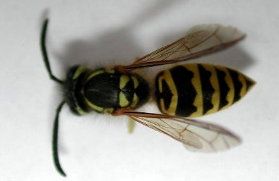

Family: Vespidae; Order: Hymenoptera)
 |
Bugs Around Your House
|
 |
|
2. Yellowjackets
|
||
|
(Scientific
name: Vespula spp;
Family: Vespidae; Order: Hymenoptera) |
| Description There are several yellowjacket species in the midwest states. The most common three in Michigan are German yellowjackets (V. germanica), common yellowjackets (V. vulgaris) and Eastern yellowjacket (V. maculifrons). Most people confuse yellowjackets with honey bees, because of their similar size and both sting. Yellowjackets (shown in right) have black and yellow patterns but honey bees are often more grey and hairy. Yellowjackets can sting multiple times (a honey bee can only sting once because its stinger becomes stuck in the flesh). Yellowjackets often nest undergound in soil, although German yellowjacket also nest inside wall cavities. |  |
|
Entrance to yellowjacket nest, located in a vegetable garden. Photo by Zachary Huang |
A yellowjecket nest with the envelop removed to show multiple layers of brood cells. Photo by Zachary Huang. |
Behavior and Biology Yellowjackets have an annual cycle, similar to paperwasps and bumble bees. Fertilized females (queens) from the previous year construct new nests around April and May in Michigan. The queens overwinter in protected areas such wall crevices, underneath sidings, generally in protected areas as queens of other social insects. The queen will forage for food (most caterpilars) and take care of her first batch of 'brood' (a term used for larvae and pupae of social insects). Once the workers (which are sterile as in honey bees) emerge, she retires from foraging task and stay home as a full time mother. Workers will forage on nectar, fruit joices, and other insects. The population of yellowjackets peaks around early September, during that time a nest can contain 800-3000 workers. When weather gets colder (Sept-October), food resources get scarce, this is when yellowjackets would come to your picnic, trying to take a sip from your coke, or a bite from your berger meat (honey bees never show these behaviors). Some people call them "meat bees" even though they are not bees. Stinging incidents are highest during this time of the year. They are aften seen eating fallen apples and other fruits.
Control and Prevention Because these wasps are predators of other insects, if they are not bothering you or not nesting close to your house, they might be doing a good job getting rid of other insects in your garden. Commercial bait traps are available for $3-10 (Oak Stump Farm Inc, [ph: 973-812-7070] sells a trap), most attract wasps with a bait and drown them with liquid underneath when they become exhausted. If there is a nest underground or inside structure near your house or garden, wait till after dark for all workers to return home, then pump dusts (Sevin), inject sprays (general bugspray or resmethrin), or pour water containing insecticides (Baygon, containing propoxur) into the hole. Cover the whole with soil after done to prevent unpoisoned wasps from escaping the next day. Some report success with pouring lots of soapy water (10 gallons) at night and hammering tight the entrance with soil. If you are allergic to insect stings, have someone help you, or call a pest control firm listed in your yellow pages.
Disclaimer: This fact sheet is for information only. Mention of products does not indicate endorsement. Prepared by Zachary Huang, Department of Entomology, Michigan State University, East Lansing, MI 48824, USA. email: bees@msu.edu.
url: http://cyberbee.msu.edu/column/stinging/yellowjacket.shtml
url: http://cyberbee.msu.edu/column/stinging/yellowjacket.pdf